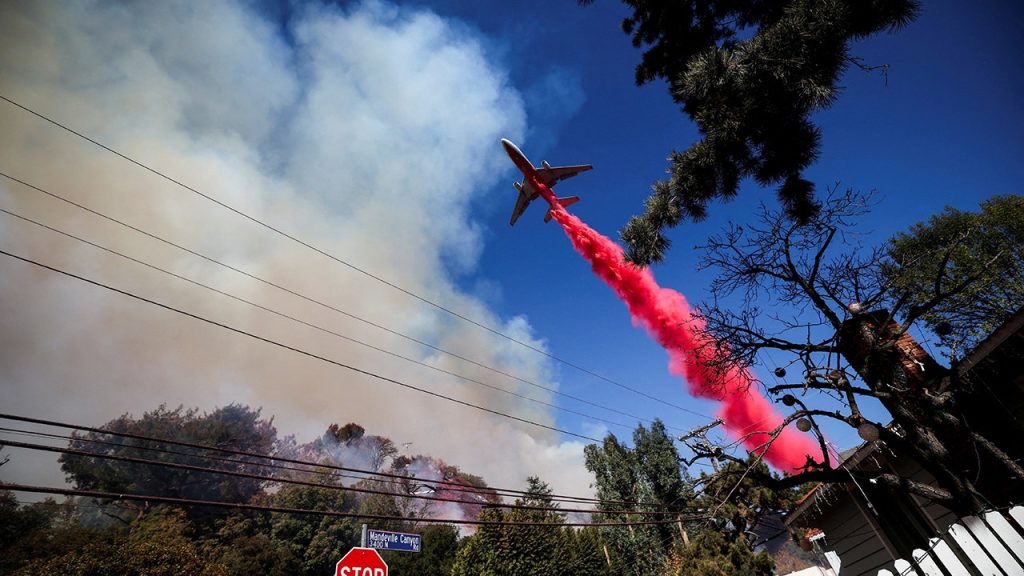The devastating wildfires raging across Southern California are painting a grim picture of a future perpetually ablaze, with fire seasons evolving into a year-round threat. Paul Petersen, head of the United Aerial Firefighters Association, describes the current situation as “totally demoralizing” for firefighters facing an unrelenting enemy. The scope and intensity of these fires, fueled by extreme weather conditions and human negligence, are pushing resources to their limits and threatening to etch their mark as some of the deadliest and most economically damaging in U.S. history. With over 40,000 acres scorched and more than 12,300 homes reduced to ashes, the human cost is staggering, leaving firefighters grappling with the frustration of insufficient resources and a seemingly insurmountable challenge. The relentless Santa Ana winds, reaching speeds of up to 80 miles per hour, transform these fires into rapidly moving infernos, leaving communities and firefighters alike unprepared for the swift devastation.
The aerial firefighting efforts, a critical component of the battle against these blazes, highlight the complexity and scale of the operation. Pilots, working eight-hour shifts in the air and 24-hour shifts overall, navigate the treacherous skies, equipped with night vision goggles for nighttime operations. Their crucial role involves relaying real-time fire positions to ground crews and strategically deploying water and fire retardant from above. The airborne arsenal includes a diverse range of aircraft, from Blackhawk and Chinook helicopters to Grumman S-2T and Lockheed C-130H air tankers, each carrying thousands of gallons of water. Supplementing this fleet are specialized “scooper” planes capable of drawing water from various sources and mixing it with retardant foam for enhanced effectiveness. This aerial force joins a massive ground effort, including Cal Fire’s fleet of over 60 aircraft and helicopters, along with Air National Guard C-130 Hercules planes equipped with advanced firefighting systems.
The sheer scale of the destruction surpasses even the harrowing images conveyed through media coverage. Fire chiefs on the ground report devastation far exceeding what can be visualized, leaving firefighters emotionally drained as their efforts seem dwarfed by the relentless flames. The loss of over 13,000 homes underscores the inadequacy of resources and fuels the frustration among firefighters who strive to protect lives and property. The combination of extreme weather, specifically the powerful Santa Ana winds, and the presence of fire creates a volatile mix that rapidly accelerates the spread of the flames. This rapid progression often leaves communities unprepared and firefighters scrambling to adapt to the unpredictable nature of the inferno. The lack of a clear “playbook” for containing such swiftly moving fires further complicates the response, leading to a desperate search for effective strategies.
Contributing to the challenges faced by firefighters are resource limitations, including depleted water supplies from fire hydrants and recent budget cuts to the fire department. These factors underscore the urgent need for increased funding and a comprehensive approach to wildfire management. Petersen stresses the importance of recognizing the year-round nature of the fire season and investing in not only fire suppression but also preventative measures such as hazardous fuel reduction and community hardening. He advocates for a multi-pronged strategy involving fuel treatments, logging, grazing, green stripping, and incentives from insurance companies for fire-adapted communities. This holistic approach, he argues, is essential to effectively protect communities from the ever-present threat of wildfires.
The current crisis serves as a stark reminder that a reactive approach to wildfire management is unsustainable. The need for proactive measures, including fuel management and community preparedness, has been a long-standing concern among firefighters, yet often ignored until tragedy strikes. The recurring cycle of devastation highlights the urgency of addressing the root causes of these fires and investing in long-term solutions. The arrest of two men on felony arson charges points to the human element in these disasters, reinforcing the importance of vigilance and public awareness. Petersen dismisses the likelihood of natural causes such as lightning or spontaneous combustion, emphasizing that the prevailing weather conditions and the absence of typical indicators point to human activity as the likely origin of these fires.
The wildfires plaguing Southern California are a wake-up call, a stark illustration of the escalating threat posed by climate change and human negligence. The shift from distinct fire seasons to a year-round fire reality necessitates a paradigm shift in our approach to wildfire management. Increased funding, proactive fuel management strategies, community preparedness, and a unified effort across local, state, and federal levels are crucial to mitigating the devastating impacts of these increasingly frequent and intense wildfires. The current crisis underscores the urgent need for a comprehensive and sustained commitment to safeguarding communities and preserving our environment from the ravages of fire.

